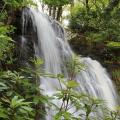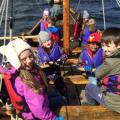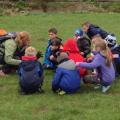News topics
Monthly Newsletters
// //// //// Online Booking //
// //// // // // // // //
For group bookings please contact
017687 77246 or
contact@derwentwater.org
Caroline Slaski, Wetherell-Dennis wedding party, June 2017
April 2016
Despite the front of the hostel looking a bit like digger-land, due to ongoing storm damage repair works to the beck and hydro-plant, lots of people have been making the most of our grounds. The Seaham and Ipswich Geography students studied the storm damage, the University of Aberdeen Forestry students studied our trees, and Katy used the beck, bridge, maps, leaves, trees, wildlife, folklore and history (basically every aspect of the grounds!) for Crook Primary School and Ashfield Junior School.
We have also sign-posted an alternative path to the waterfall, used our new footbridge countless times, replaced our old football goals, and installed a new bike shed. We hope these positive improvements will compensate for the diggers that currently out-yellow the daffodils. Have a lovely May - one of Kathy's favourite months!

At the beginning of April 17 students from the University of Aberdeen School of Biological Sciences came to stay for a forest-management study week, organised by Dr Louise Page. Making the most of our grounds and the local area, the programme included tree identification exercises, visits to Whinlatter Forest and Watendlath, and a walk-and-talk with National Trust Ranger Maurice Pankhurst. The group also did some practical forest-management for us, taking up a few invasive young Western hemlocks along the waterfall path. Three of the students told me a bit more about their visit:
Veronika from Slovakia is an MSc Environmental and Forest Management student, interested in research, and she told me about their Tree ID exercises. One involved going to ten marked trees in our grounds, while the other one took place in the dining room on the last night, with branches that Louise had collected during the week. Both exercises were quite challenging, particularly as most of the deciduous trees had not yet come into leaf.
Joshua, originally from Bombay, is also an MSc student, interested in broadleaf forest research. He told me about their visit to Moffat, a harvesting site on the way from Aberdeen to Derwentwater, and their intended visit to Carrifran Wildwood for the journey home.
Ben from England is an undergraduate Zoology student in his fourth and final year, but his interest in trees, and the forestry course that he did in his third year, made him eligible for the trip. He told me about their visits to Whinlatter Forest (7 miles from the hostel) and the walk-and-talk with Maurice. Maurice showed the group how he is trying to encourage greater biodiversity along Derwent Water with the establishment of scrub. and he took the group on a tour of the lakeshore, Great Wood, Ashness, and Watendlath. He talked about forest and deer management, and expressed some reservations about conifers in Borrowdale!
It was great to meet such a hard-working group, and I was able to use some of their wisdom in my activities with Crook Primary School and Ashfield Junior School. In fact, when acting out a selected history of Borrowdale, told through the relevant trees in our grounds, I finished by the ‘parent’ Western hemlock, using the Aberdeen students and the National Trust as examples of present-day forest management and uses of the hostel grounds.

On Monday 25th April 31 Year 4 pupils from Crook Primary School (County Durham) came to stay for a one night residential, focusing on Viking history and its associations with Borrowdale.
One group did activities with Platty+ at Lodore (shield design, home-life and travels, and rowing a Viking-style boat on Derwent Water), while the other group adopted Viking names and went for a walk with Katy. The following day the groups swopped over.
The activities with Katy were based around a walk to Falcon Crag, looking out for Viking words on the OS map along the route (crag, beck, knotts, water, gill, fell etc) and exploring these features close-up. From Falcon Crag there was a fantastic view of the Platty+ Viking boat on Derwent Water, and we all enjoyed playing on Brown Knotts, experiencing first-hand the meaning of the word knott (rocky hill). Some of the children recognised the view from the new Star Wars film!
We also acted out some Viking sagas and scenarios, based around relevant trees in our grounds. By an ash tree we acted out the Norse creation saga, with the ash being the Tree of Life and the source of the first man, Ask. It is even said that a squirrel called Ratasok scampered up and down the Tree of Life, delivering messages between the eagle at the top and the dragon at the bottom, and sure enough a red squirrel appeared for the children!
Under the lime tree we acted out 'The Thing', a Viking community meeting which often took place under lime trees, the Tree of Truth. Disputes and problems were settled at The Thing, and the lime tree helped people come to the truth.
By an oak tree we discussed the long voyages of the Vikings, with oak being an important boat-building material, and we finished by our veteran yew tree, which probably started growing soon after the main period of Viking influence in Borrowdale, with yews often marking the site of Pagan Viking worship.
We concluded our activities by writing Barrow House postcards, signing them in Viking runes: how fluent are the Crook postmen in old Norse? Well done to all of the Crook pupils and their teachers - you really brought the Borrowdale Vikings to life!

On 27th April 55 Year 3 pupils from Ashfield Junior School (Cumbria) came to stay for a two night residential. They experienced sunshine, sleet, snow, hail and rain, but we still managed to do lots of outdoor activities.
Day 1: a visit to Whinlatter Forest for woodland activities with Classrooms in the Forest (Phil Cheesley and Barbara Thomson). An evening of glorious sunshine, though chilly, with plenty of time to play in the grounds.
Day 2: a full day of activities in the hostel grounds, organised by Katy. The pupils took part in 5 different activities, based on the theme of Trees and Woodland.
The fire-making activity, incorporating discussion of wild fires (very relevant due to two recent wild fires in Borrowdale) and woodland management, was led by Mark Astley and Jessie Binns of the National Trust.
The Wildlife and Woodland activity, using binoculars and magnifying glasses, was led by Classrooms in the Forest. The children were very happy to see Phil and Barbara again.
The Tree Tales activity was led by Katy, with the children (the Ashfield Imps!) travelling through 500 million years of history, improvising aspects of tree-related history and folklore. We started with the native trees, those that grew naturally in Borrowdale after the last glaciation, and finished with some of the non-native trees that wealthy owners of Barrow House introduced from abroad.
The fourth activity was a walk along the waterfall path, learning about the beck and storm damage, sketching the waterfall, and looking in detail at the leaf and bud features of selected trees.
The fifth activity was a poetry activity, with the children learning about Haiku, Kennings and Acrostics. They wrote tree-related poems, laminated them against leaves, and hung them on trees, creating a poetree trail.
At the end of the day we all gathered in the dining to create a Charter for Woodland, Trees and People (an initiative established by the Woodland Trust), discussing the importance of trees, and writing down our tree-related memories and stories. We stuck them on a painting of Derwent Island (the island that Joseph Pocklington bought in 1778, deforesting it to make way for his mansion and follies) and sent a picture of it to the Woodland Trust. By this point the sky was a mixture of rain, sleet, and snow, and the children were happy to play indoors, read stories, and eat a good tea.
Hopefully some of the pupils will find a branch from a beech tree (the Tree of Wishes) on the ground, attach a wish to it, and stick it in the earth for the fairies to consider: a wish for warmer weather for next year’s Ashfield residential would be good!
During the Easter holidays a group from the 3rd Gateshead Boys’ Brigade came to stay. Here is Alex Todd with an account of their visit:
'On Thursday we travelled from Gateshead by car and spent the afternoon on the rocks near Quay Foot Quarry (Bowder Stone area), for a climbing session led by the Boys’ Brigade Mountaineering Club. Although the weather wasn't favourable, making the rock cold and slippery, we still went ahead with the activity and all enjoyed it despite the poor conditions. Following this, we returned to Derwentwater Hostel - our lodgings for the visit.
On Friday we awoke early and drove to Seathwaite with the intention of climbing Great Gable. After crossing through a farm and over a bridge, we began to ascend with excellent views of an adjacent waterfall and the Borrowdale Valley. The weather was much better - warm and sunny - and after several stops for food and water we reached the summit of Green Gable, a smaller mountain near Great Gable. By this point fog and cloud had descended on our position, and after eating lunch we put on hats and gloves and reached Great Gable's summit. After descending down scree (a challenging experience to say the least!) we passed a tarn and returned to our vehicles, then back to the hostel for a much needed shower, evening meal and sleep.
On Saturday we drove to the southern end of Derwent Water for canoeing with Platty+. The weather wasn't good but we braved the conditions and headed out onto the lake in rafted canoes (two canoes strapped together.) We rowed across the lake through the pelting rain and battering wind to a small peninsula where we moored the boats and walked up to admire some rather compromised views of Derwent Water and the surrounding hills (Skiddaw was not visible due to low cloud.) As we were going back with the wind, we put up a sail and coasted along comfortably, without requiring input from rowers. After coasting for several minutes, we climbed aboard the powered safety boat, then returned to the pontoon and landed. We returned to the hostel for lunch and then parted ways, some of us visiting Keswick. We all enjoyed our annual visit and look forward to attending next year.'
Thank you for such a vivid account – what an active visit! We look forward to seeing more Boys’ Brigade members next year.
Nicola has been out and about, looking for the decorated model Herdwick ewes that have popped up across the Lake District. The Go Herdwick public art trail (runs until 4th September) has been created by the Calvert Trust, a local charity which provides adventurous activities for disabled people. Here is a summary from the Calvert Trust:
As part of our Anniversary Celebrations, 2016 will see the central Lake District invaded by a flock of 60 life sized decorated fantasy Herdwick ewes appearing in unexpected places - all paying homage to the Herdwick’s iconic status and all in support of our 40th Anniversary Capital Fundraising Drive.
The ewes have been decorated by different artists and community groups, and you can find more information, including where to buy trail guides, here:
http://www.goherdwick.co.uk/trail-maps/
We also have a trail booklet on display on our noticeboard, and Nicola is rapidly becoming an expert on all the ewe locations and decorations!





